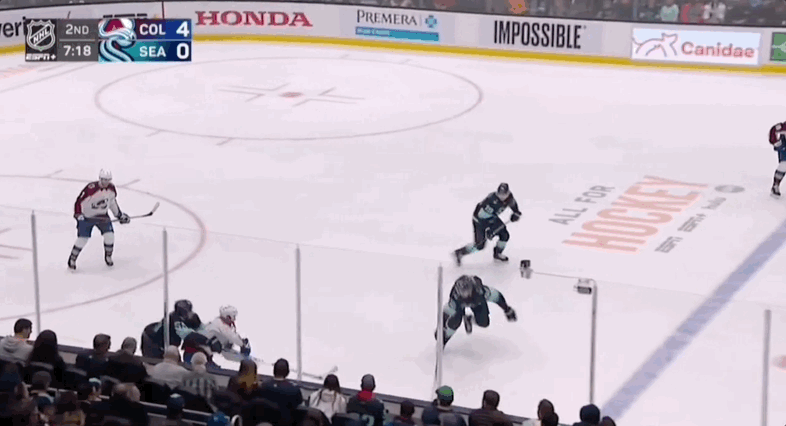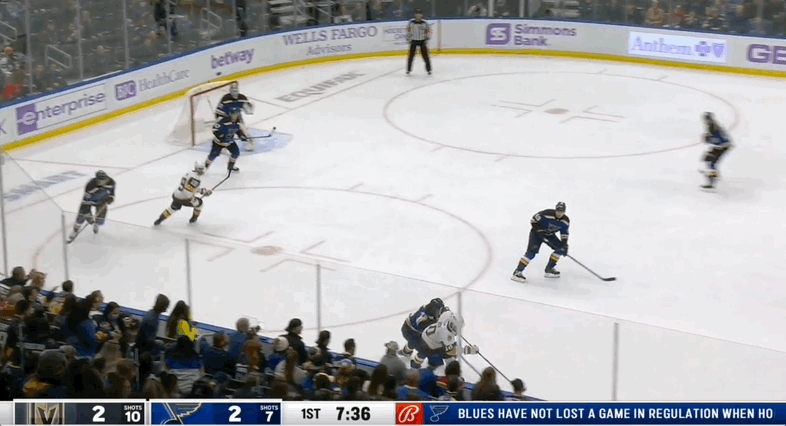American Thanksgiving serves more purpose than just a day off from hockey in the NHL. For many, it’s an important benchmark in the season.
Not only does it usually represent about the quarter-mark into the season, but a high percentage of teams that are in a playoff spot at American Thanksgiving end up qualifying for the post-season.
So given the implications of this holiday, along with the fact that we finally have a decent sample of games to analyze, let’s talk about what we’ve seen so far in 2021-22.
What’s surprised us...
The Young Ducks
Before the season started, Anaheim was expected to be closer to the bottom of the Pacific Division. With Thanksgiving approaching, they’re third in the division (by a slim margin, Vegas is only one point behind, but more on that later).
A lot of credit goes to some of their Ducklings, primarily Trevor Zegras and Troy Terry. These two generally don’t play together at 5-on-5, which helps spread out scoring threats in the top-six.
So far, Terry has exceeded his expected goal total and he probably won’t shoot 27 per cent forever. But what’s contributing to his success is a high shot rate relative to his teammates at 5-on-5 and driving to the slot. His mainstay centre’s passing (Ryan Getzlaf) has helped Terry's shooting, but they aren’t too predictable with Terry only taking shots. The winger’s passing the puck at a high rate too at 5-on-5, which is showing on the scoresheet as well.
Then on the second line, there’s Zegras. We already know the Ducks’ forward is one of the best puck-movers in the league. He frequently tries to carry the puck right into the offensive zone to spark a play. Once in the zone, Zegras is one of the team’s leading passers, often setting up plays off the rush, east-west shot assists that cross the centre line up from the blue paint to the blue line, and passes to the dangerous slot area. Plus, his shot isn’t too shabby either. Zegras is a dual threat, and he’s just getting started. So even if the Ducks start to trend in the wrong direction and can’t maintain this start, the future is still bright.

Goalie Bounce Backs
A goaltender can be the great equalizer in hockey, and their play can make or break a team. Two teams high in the standings -- leading both of their respective divisions with 29 points each -- have to credit their netminders for contributing to their strong starts.
Frederik Andersen has been a key part of the 14-2-1 Hurricanes’ success. Some teams were rightfully hesitant to sign the former Leafs netminder in free agency based on his play declining in recent seasons. But so far, he’s rewarding the Hurricanes for giving him a chance to rebound. He doesn’t face a high rate of shots against, nor is he often being peppered from the slot. But he’s stopped 94 per cent of the shots he has faced in all situations and has allowed almost 15 goals fewer than expected on those shots on goal.
Sergei Bobrovsky’s rebound has helped the 13-2-3 Panthers get this far, too. Kicking off the third year of a seven year, $10 million contract, he didn’t quite have the same flexibility to find a fresh start like Andersen with the Hurricanes. While Chris Driedger leaving in the expansion draft lessened Bobrovsky's competition, Spencer Knight’s full time presence with the team put even more pressure on the veteran goalie to have a strong season, or risk being outplayed for the starter’s net.
Bobrovsky doesn’t have the toughest of workloads either thanks to a strong team in front of the blue paint. His shot rate against in all situations is just below average, as are the rate of shots from the slot area just in front of the crease. But importantly for the team is how he’s responded to that workload. Bobrovsky’s stopped 94 per cent of the shots he’s faced, and he’s saved about 11 goals above expected.
What's disappointed us...
Seattle Goaltending
With the good, we also have to take the bad. Sticking with the goaltending theme, we turn our attention to the Seattle Kraken. We know the Vegas Golden Knights set extremely high (and somewhat unreasonable) expectations for an expansion team. The Kraken obviously haven’t matched that with a 5-12-1 record that lands them second to last in the league.
At 5-on-5, the Kraken are one of the best teams at limiting shot volume against. They even keep their opponents from the slot pretty often; their rate of 17.2 slot attempts per 60 is the second lowest in the league. In theory, even though we know it can take Philipp Grubauer time to adjust to a new team, the Seattle defence should ease him (and Chris Driedger) in after playing behind one of the best teams on both ends of the ice last year in the Colorado Avalanche.
Unfortunately, that hasn’t been the case as Grubauer has only stopped 88 per cent of the shots he’s faced at 5-on-5. On paper, the goaltending in Seattle hasn’t been as advertised. It’s possible that digging into the kinds of chances goaltenders are facing holds some weight here. There’s more to shot quality than just location. Alison Lukan of the Seattle Kraken explored some other elements that influence the danger of a shot including how shots coming off a rush are more difficult to defend and ultimately stop by the goaltender; an odd-man rush only makes it more challenging. So that could be part of the equation.
While there’s room for improvement from the five skaters on the ice in limiting rush attempts against to ease the workload for their netminders, primarily starting goaler Grubauer, at the end of the day those rush attempts can be the key times they need saves -- and they just haven’t gotten that to start their inaugural season.

Slow starts from expected contenders
Coming into the season, most had the Islanders and Golden Knights penciled into the 2022 post-season -- and rightfully so. Both were contenders last year, and neither made too many major changes over the summer to set them back.
Some of their struggles have been out of their control. The Golden Knights have been bitten hard by the injury bug with Mark Stone, Max Pacioretty, William Karlsson, and Shea Theodore all missing time at points this season. The Islanders, on the other hand, have had to manage without a home arena until just last week, and now are dealing with a COVID-19 outbreak.
Managing with the depth they had was obviously tricky for Vegas. Those personnel losses pushed players to step up, and sometimes do too much which can actually have adverse effects. That may have been the case for Alex Pietrangelo in the early goings of the season.
But the extent to which Vegas has been outplayed at 5-on-5 really departs from where this team left off last season. Not only have the Golden Knights fallen short offensively, but they’ve conceded a lot against. This season, they’ve become a bottom-10 team in shot rate against. Allowing shots against can be manageable if a team is holding their opponent to the perimeter and protecting the middle of the ice. That hasn’t been the case in Vegas to open the season, though; they’ve allowed their opponents to move right into the slot and attempt 22.2 shots against. About 37 per cent of the shots they’ve conceded have come from the slot area -- and the only team to allow more inner slot shots against than the Golden Knights are the Senators.

The good news is that their play is starting to trend in the right direction as of late, below the surface. A healthy Stone obviously contributes to that, and Pacioretty could return soon too. So hope isn’t lost -- as long as Vegas' top players stay healthy, their play should start trending in the right direction.
As for the Islanders, defensive structure is the name of their game. This season, though, they’ve allowed a high rate of shot attempts against after opening the year with 13 games on the road. They have, however, blocked quite a few of those shots so a slightly lower rate have reached the net. Still, it’s a departure for them to be a bottom-10 team in shots against, let alone quality shots. At the other end of the ice, they’ve stuck to their quality over quantity strategy. And where they really rank high is getting to the slot area off the rush. But their offensive generation isn’t exceeding what they’ve allowed, and that’s really shown over the Islanders' last string of games.
Once some of their core players return from COVID protocol and they’re actually able to deploy a fuller squad on home ice, the tide should turn. They’re not going to shoot under seven per cent at 5-on-5 forever, either. But their weaknesses started before so many players were lost to protocol. There’s legitimate work to be done, and now that they have more stability with their schedule that may help New York's quest to climb the standings.
What we’re watching...
American Thanksgiving isn’t the perfect measurement for a team’s chances at the post-season. And this year, there are a few teams outside the current playoff bubble -- including the aforementioned Islanders -- that most would expect to be there. So now, the question is which of them can push their way up the standings after what could appear to be a less than ideal start on the surface.
The Flyers injury woes, now without Kevin Hayes and Ryan Ellis again for some time, will make it an uphill battle. The Bruins, on the other hand, may be sixth in the Eastern Conference wild card race, but have just 15 games played. Their points percentage (.600) is more indicative of Boston’s play than their place in the standings. But there are still three strong teams to try to push out of a divisional spot ahead of the Bruins in Florida, Toronto, and Tampa Bay. There’s clearly quite a bit that can change in the Eastern Conference, so the question is what percentage of the teams currently slotted for the playoffs actually make it?
As for the West, the only team currently outside of the playoff mix who are universally expected to contend this season is Colorado. Like Boston, they’re only at 15 games on the season.

Sorting by points percentage pushes Colorado up to second in their division. The Avalanche did get off to a slower start this season, but seem to have found their footing, especially since Cale Makar returned, even while still missing Nathan MacKinnon. They should find themselves right back in playoff standing, as long as they can at least get average goaltending.
Data via Sportlogiq
